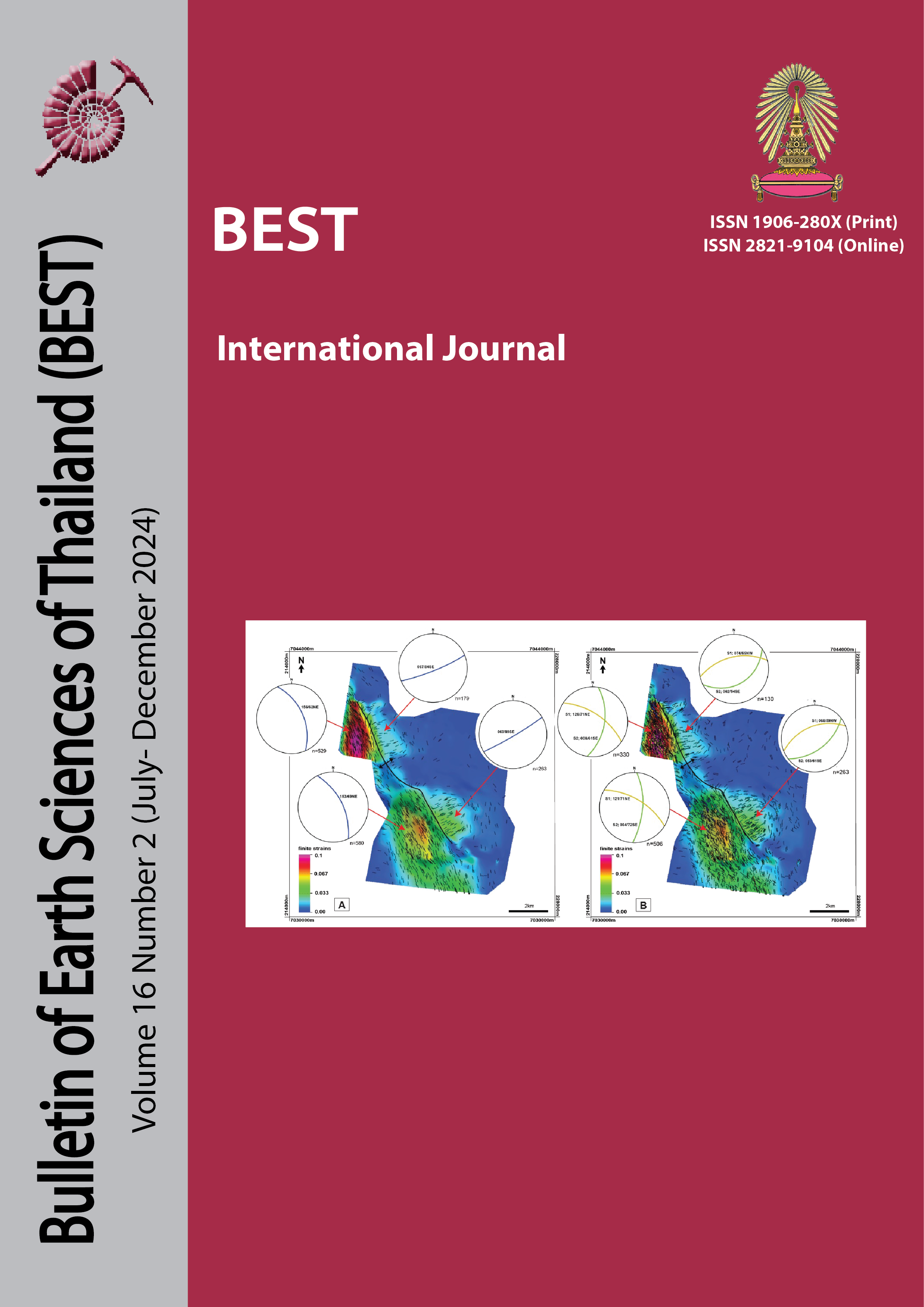STRUCTURAL CHARACTERISTIC OF EARLY EOCENE EXTENSIONAL FAULT IN SONGHKLA BASIN, GULF OF THAILAND
Main Article Content
Abstract
The Songkhla Basin is a classic example of a Cenozoic rift basin in the Gulf of Thailand. The basin is 75 km long (N-S) and 30 km wide (E-W). Its primary geometry is strongly influenced by the main N-S to NNW-SSE, east-dipping boundary fault zone on the western side of the basin, forming an elongated half-graben under E-W extension since the Eocene. Many faults strike predominantly orthogonal to the extension direction. In this study, a set of E-W to WNW-ESE, north-dipping extensional faults is mapped based on 3D seismic data, occurring in the early Eocene syn-rift strata. The younger, N-S striking normal faults either cut across or terminate against the older, basement-involved, E-W to WNW-ESE striking normal faults. The presence of both types of fault interactions in the Songkhla Basin suggests the possibility of multiple phases of non-coaxial extension during the Eocene. This study presents the structural characteristics and 3D geometry of the early Eocene extensional faults, with a discussion on tectonic development.
Article Details

This work is licensed under a Creative Commons Attribution-NonCommercial-NoDerivatives 4.0 International License.
Copyright © 2008 Department of Geology, Faculty of Science, Chulalongkorn University. Parts of an article can be photocopied or reproduced without prior written permission from the author(s), but due acknowledgments should be stated or cited accordingly.
References
Bangpa, N., Morley, K., Ghosh, J., & Mankhemthong, N., 2020, Stratigraphic and Structural Evolution of Nakhon Basin, Gulf of Thailand, Songklanakarin Journal of Science and Technology, 42(6), 1334-1343
Chen X., Liu J., Burg J., Tang Y., Wu W., & Yan J., 2020. Structural evolution and exhumation of the Yulong dome: Constraints on middle crustal flow in southeastern Tibetan Plateau in response to the India-Eurasia collision. Journal of Structural Geology 137.
Dewey, John & Cande, Steven & Pitman, W.C., 1989. Tectonic evolution of the India/Eurasia Collision Zone. Eclogae Geologicae Helvetiae. 82.
Henza A., Withjack M., & Schlische R., 2010. Normal fault development during two phases of non-coaxial extension: An experimental study. Journal of Structural Geology 32(11), p. 1656-1667.
Kaewkor, C., Watkinson, M.P., & Burgess, P.M., 2015. Structural Style and Evolution of the Songkhla Basin, western Gulf of Thailand.
Kartika sari H., 2011. Structural Style of Songkhla Basin, Gulf of Thailand. Bulletin of Earth Sciences of Thailand 4(2), p. 25-31.
Morley C., & Racey A., 2011. Tertiary stratigraphy. In: Ridd MF, Barber AJ, Crow MJ, editors. The Geology of Thailand. London: Geological Society; p. 223–271.
Morley C., & Wang Y., 2023. The Cenozoic hyper-oblique collision zone of Indochina: A re-appraisal of escape tectonics. Earth-Science Reviews, 243.
Paramita D., 2021. Structural Evolution of the Songkhla Basin, Gulf of Thailand: A Palinspatic Restoration Study. Bulletin of Earth Sciences of Thailand 5(2), p. 38-47.
Poosongsee J., & Morley C.K., 2018. Evolution of a major extensional boundary fault system during multi-phase rifting in the Songkhla Basin, Gulf of Thailand. Journal of Asian Earth Sciences 172, p. 1-13.
Rivas S., Grimmer J.O.W., Alaminos A., & Navarro J., 2016. Basin Modelling at the Songkhla Basin (Gulf of Thailand) or How Many Source Rocks Do I Have? AAPG/SEG International Conference and Exhibition, Barcelona, Spain, April 3-6, 2016.
Searle P., & Morley C.K., 2011. Tectonic and thermal evolution of Thailand in the regional context of SE Asia. In: Ridd, M.F., Barber, A.J., Crow, M.J. (eds.), The Geology of Thailand. Geological Society of London.
Sautter B., & Pubellier M., 2022. Structural control of Mesozoic orogens on SE Asia Basin opening. Journal of Asian Earth Sciences, 230, 105207
Sautter B., et al., 2017. Late Paleogene rifting along the Malay Peninsula thickened crust. Tectonophysics 710-711, p. 205-224


